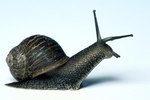Hermit crabs make relatively low-maintenance pets, but you can also study and experiment on them for educational purposes. Although hermit crabs often die quickly due to mistreatment or neglect, they can live up to 40 years, according to Hermit Crab Paradise. They also act different in social groups and can survive on a variety of foods and in various habitats. This makes hermit crabs rich subject matter for observation and experimentation.
Diet
Hermit crabs are literally bottom feeders that will eat almost anything, from factory-processed pellets to cooked meat. Experiment with different foods and record which ones the crabs prefer. Place a buffet-style platter out every day and see if there is a consistent preference to determine whether or not hermit crabs have individual or species-based taste. For long-term studies, you could keep crabs separate and feed them different diets to observe the effects.
Habitat
Experiment with the hermit crabs' environment to see the results. Since they are native to the tropics, hermit crabs enjoy humid weather. Change the humidity and observe changes in behavior, eating habits and activity. Provide different types of obstacles and digging material to see what the hermit crabs prefer or gravitate towards. Use large rocks, gravel, sand, dirt or artificial materials.
Movement
Try to see if there is a correlation between hermit crab movement and time of day, diet, training or any other factor to come to a conclusion about their movement practices. If you don't feed them for a day, see if they move less or more. It's perfectly safe for a crab to go without food for at least three days.
Behavior
Hermit crabs act differently by themselves than they do in large or small groups. Their behavior may also change due to the weather, season or health. Experiment with hermit crab behavior by manipulating habitat and group dynamics. See if you can teach hermit crabs to come out at a certain time by always feeding them on schedule. They love being misted with water, so use that as a treat.
References
Photo Credits
-
hermit crab image by max blain from Fotolia.com
Writer Bio
Ricky Andromeda has been writing since 1999. His articles have been published on various websites, specializing in pool, art, hunting, antiques, home improvement, chemistry and gambling. He holds a Bachelor of Arts in English from Louisiana State University and is pursuing a Master of Fine Arts in writing at the University of Arkansas.





